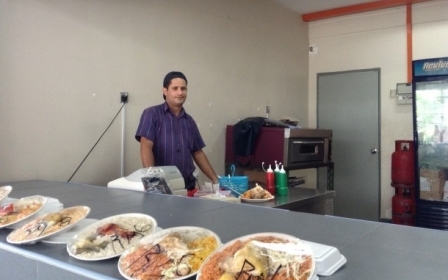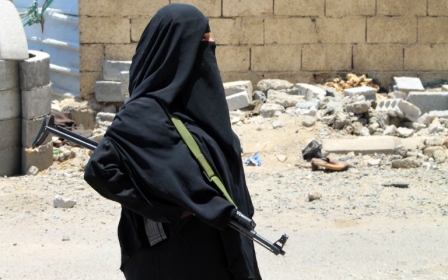Creativity and destruction in war-torn Yemen
Yemenis in the capital Sanaa are still picking up the pieces from a huge explosion that ripped through the city on Tuesday, as a duo of artists try to make sense of the destruction through creativity.
At least 40 people were killed and dozens more injured when an airstrike targeted an underground weapons depot in a mountain just outside Sanaa, sending shockwaves through the city.
Windows were shattered in houses up to two kilometres away – amateur footage of the explosion, taken from a residential building in Sanaa, shows shards of broken glass raining down from all directions in the aftermath of the blast.
When the dust settled after the explosion - the largest to hit Sanaa since a Saudi-led coalition launhed a bombing campaign against Yemen's Houthi militants last month - a pair of young artists decided to harness the disaster into something creative.
Setting out early in the morning two days after the blast, Bushra al-Fusail, a photographer and women's rights activist and her friend Nina Aqlan, a social entrpreneur, drove around the city collecting shards of glass in a cardboard box.
An ongoing fuel crisis has meant that rubbish collectors are out of action, and refuse is piling up in the streets.
But alongside the garbage were raw materials for the artwork: shattered glass from the windows of residential houses and shops, that has littered the streets since the explosion.
“Broken glass is everywhere, like snow in the street,” said Bushra al-Fusail, co-founder of FRAME Yemen, a online platform where citizens use photography and film to document local communities.
“There is no petrol for cars, so nobody is collecting the glass. Everybody just takes it out to the main street.”
Combatting division
After sorting through the fragments, Aqlan and Fusail assembled a mural of Yemen's national flag, adfixing it to a wall on a busy street. They say they aimed to use detritus from the explosion to create an expression of national unity.
The more than month-long air and sea campaign against the Houthis, coming on the back of months of turmoil, has threatened to deepen rifts in the poorest country in the region, which already had a decades-long southern secessionist movement demanding independence from the wealthier north.
The 'fragment flag' is now in Hadda Street, a busy thoroughfare in central Sanaa. Faj Attan, the mountain just north-west of the capital that was targeted, is still so dangerous that the artists decided not to put the memorial there, in case it is destroyed again. There are still known weapons stores in and around the mountain, and locals fear an airstrike could be repeated in the near future.
“We wanted to be sure that it was in an area that’s safe to go to,” said Fusail.
Like most in Sanaa, the artists have been badly affected by the violence, and especially by the Faj Attan blast.
Fusail’s office at the International Organisation for Migration, which has its headquarters in north-western Sanaa, was badly damaged in the attack.
“I was lucky, because our office has a panic room, with reinforced windows and doors. But when we went upstairs to the first floor we discovered that all the windows were shattered and the doors were off their hinges. My house is a bit further away, but all the windows were still broken.”
Hope and sadness
The flag has provoked mixed reactions from passersby, some of whom are traumatised by violence on all sides that has killed over 1,000 people since strikes began on 26 March.
“Like any other art piece it’s always open to interpretation, and we want people to make it their own,” Aqlan told MEE via Skype from Sanaa.
For Fusail, though, the flag represents optimism for the future, despite dashed hopes of a ceasefire earlier this week.
“Glass reflects a lot of things – it’s like a mirror,” Fusail said. “Everyone can walk by and see something beautiful reflected in it.”
The artists are planning to create other found-art memorials to victims of the violence in Sanaa and throughout Yemen. One material they would never work with, though, is bullets.
“I really hope they stop the war because I don’t want to have to work with bullets,” said Fusail. “They’re an ugly thing to see.”
New MEE newsletter: Jerusalem Dispatch
Sign up to get the latest insights and analysis on Israel-Palestine, alongside Turkey Unpacked and other MEE newsletters
Middle East Eye delivers independent and unrivalled coverage and analysis of the Middle East, North Africa and beyond. To learn more about republishing this content and the associated fees, please fill out this form. More about MEE can be found here.





